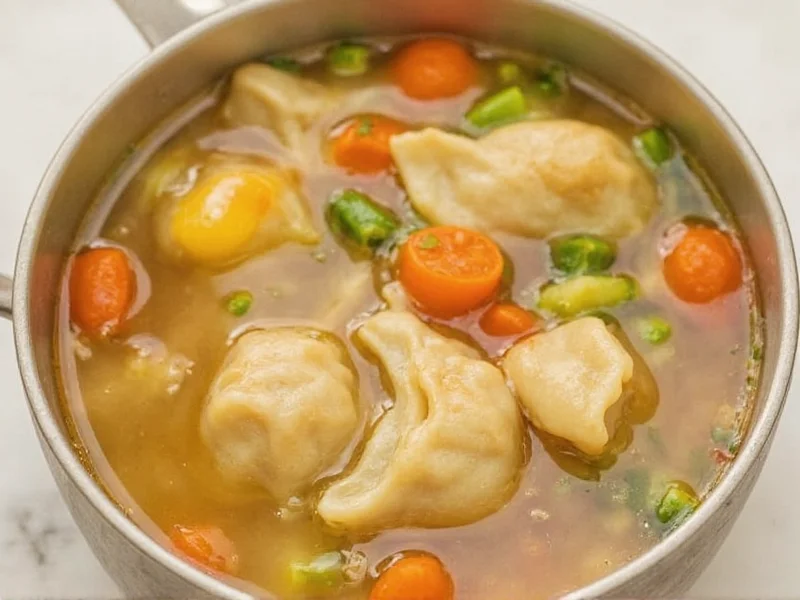Creating authentic chicken dumpling soup requires attention to both the broth and dumpling texture. This traditional comfort food combines tender chicken, flavorful vegetables, and light dumplings that float perfectly in a golden broth. Unlike shortcut versions that use baking mix or canned broth, this method builds flavor from scratch while ensuring your dumplings maintain their delicate structure without dissolving into the soup.
Essential Ingredients for Perfect Chicken Dumpling Soup
| Component | Ingredients | Key Substitutions |
|---|---|---|
| Broth Base | 3 lbs chicken bones, 2 onions, 3 carrots, 3 celery stalks, 10 cups water, 2 bay leaves, 1 tsp black peppercorns | Use store-bought low-sodium broth if short on time (8 cups) |
| Chicken | 2 lbs boneless chicken thighs (or 1 whole chicken) | Turkey thighs work well for variation |
| Dumplings | 2 cups all-purpose flour, 1 tbsp baking powder, 1 tsp salt, 1/2 cup cold butter, 3/4 cup milk | Gluten-free flour blend, vegan butter, almond milk |
| Vegetables | 3 carrots (diced), 3 celery stalks (diced), 1 onion (finely chopped) | Parsnips, leeks, or turnips for variation |
| Seasonings | 2 tsp dried thyme, 1/4 cup fresh parsley, salt to taste | Rosemary or sage for different flavor profile |
Step-by-Step Chicken Dumpling Soup Preparation
Building the Flavor Foundation
Start by creating a rich broth that forms the soul of your soup. Place chicken bones in a large stockpot with cold water, bringing slowly to a simmer. Skim off any foam that rises to the surface during the first 20 minutes. Add roughly chopped vegetables (no need to peel), bay leaves, and peppercorns. Simmer uncovered for 2-3 hours, reducing liquid by about one-third. This slow extraction process pulls maximum collagen and flavor from the bones, creating a broth that gels when chilled.
Preparing the Chicken and Vegetables
While broth simmers, poach chicken thighs in a separate pot of salted water for 25-30 minutes until fully cooked. Remove chicken, reserving the cooking liquid to add to your broth if needed. Shred the meat, discarding any fat or connective tissue. After straining your broth, return it to the pot with the shredded chicken and fresh diced vegetables. Simmer for 15-20 minutes until vegetables reach tender-crisp texture.
Crafting Perfect Dumplings
The secret to light, fluffy dumplings that don't dissolve lies in proper technique. Combine flour, baking powder, and salt in a bowl. Cut cold butter into the mixture until it resembles coarse crumbs. Stir in milk just until combined—overmixing creates tough dumplings. The batter should be shaggy and slightly lumpy. Using two spoons, drop golf ball-sized portions directly onto the simmering soup. Cover immediately and cook undisturbed for 15 minutes—this prevents the dumplings from sinking and ensures proper steaming.
Pro Tips for Chicken Dumpling Soup Success
Dumpling Texture Troubleshooting
Many home cooks struggle with dumplings that become dense or dissolve. To avoid this common issue:
- Maintain a gentle simmer, not a rolling boil, when cooking dumplings
- Never stir after adding dumplings to the soup
- Use cold ingredients for the dumpling batter
- Don't overmix the batter—lumps are acceptable
- Cover the pot tightly to create proper steaming conditions
Broth Enhancement Techniques
For restaurant-quality depth of flavor, try these professional techniques:
- Roast chicken bones at 400°F for 30 minutes before making broth
- Add a parmesan rind during the last 30 minutes of simmering
- Finish with a splash of apple cider vinegar to brighten flavors
- Skim fat from chilled broth before reheating for clearer soup
- Add fresh herbs during the last 5 minutes of cooking
Common Mistakes to Avoid When Making Chicken Dumpling Soup
Even experienced cooks make these frequent errors when preparing traditional chicken dumpling soup:
- Boiling instead of simmering - A vigorous boil breaks apart dumplings and makes broth cloudy
- Overcrowding dumplings - Leave space between drops for even cooking and proper expansion
- Peeking too soon - Lifting the lid during dumpling cooking releases steam needed for proper rise
- Using warm ingredients - Cold butter and milk create steam pockets for light texture
- Adding dumplings to cold soup - Always add to actively simmering liquid
Serving and Storage Recommendations
Serve chicken dumpling soup immediately in pre-warmed bowls. The dumplings continue cooking off-heat, so timing is crucial for perfect texture. Garnish with fresh parsley and a crack of black pepper. For leftovers, store soup and dumplings separately if possible—dumplings will absorb broth and become soggy when refrigerated. Reheat gently on the stove with a splash of water or broth to restore proper consistency. Properly stored, the soup base keeps for 4 days refrigerated or 3 months frozen.
Variations for Dietary Needs
This traditional chicken dumpling soup adapts well to various dietary requirements:
- Gluten-free version: Use 1:1 gluten-free flour blend and ensure broth is GF certified
- Dairy-free option: Substitute butter with coconut oil and milk with unsweetened almond milk
- Lower-carb adaptation: Replace dumplings with cloud dumplings (egg white and cream cheese)
- Vegetarian alternative: Use mushroom broth with seitan "chicken" and vegetable dumplings











 浙公网安备
33010002000092号
浙公网安备
33010002000092号 浙B2-20120091-4
浙B2-20120091-4